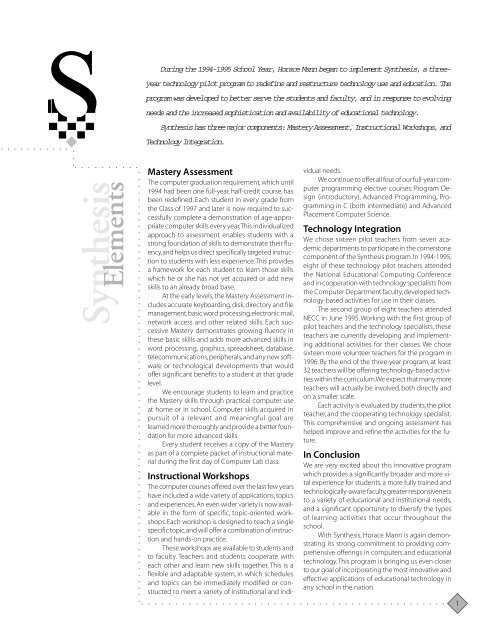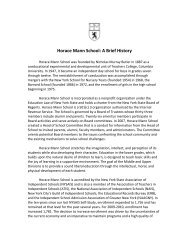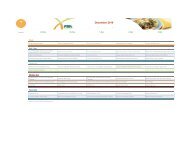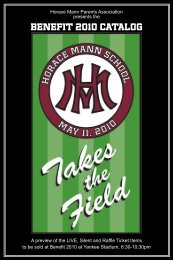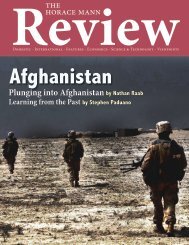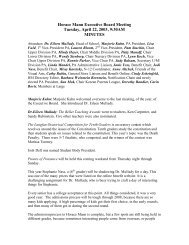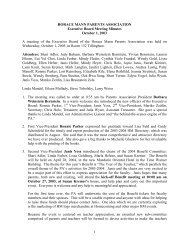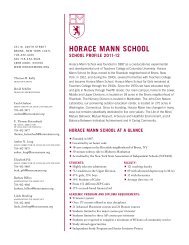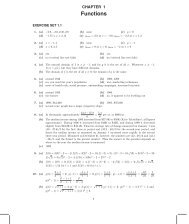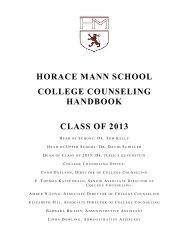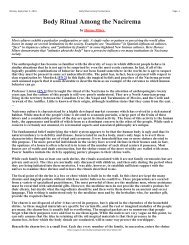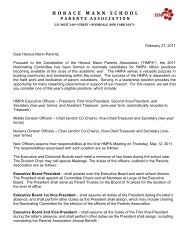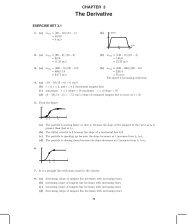description and history - Horace Mann School
description and history - Horace Mann School
description and history - Horace Mann School
You also want an ePaper? Increase the reach of your titles
YUMPU automatically turns print PDFs into web optimized ePapers that Google loves.
○ ○ ○ ○ ○ ○ ○ ○ ○ ○ ○<br />
○ ○ ○<br />
○ ○ ○ ○ ○ ○ ○ ○ ○ ○ ○ ○ ○ ○ ○ ○ ○ ○ ○ ○ ○ ○ ○ ○ ○ ○ ○ ○ ○ ○ ○ ○ ○ ○ ○ ○ ○ ○ ○ ○ ○ ○ ○ ○ ○ ○ ○ ○ ○ ○ ○ ○ ○ ○ ○ ○ ○ ○ ○ ○ ○ ○ ○ ○ ○ ○ ○<br />
○ ○ ○ ○ ○ ○ ○ ○ ○ ○ ○ ○ ○ ○ ○ ○ ○ ○ ○ ○ ○ ○ ○ ○ ○ ○ ○ ○ ○ ○ ○ ○ ○ ○ ○ ○ ○ ○ ○ ○ ○ ○ ○ ○ ○ ○ ○<br />
S<br />
During the 1994-1995 <strong>School</strong> Year, <strong>Horace</strong> <strong>Mann</strong> began to implement Synthesis, a threeyear<br />
technology pilot program to redefine <strong>and</strong> restructure technology use <strong>and</strong> education. The<br />
program was developed to better serve the students <strong>and</strong> faculty, <strong>and</strong> in response to evolving<br />
needs <strong>and</strong> the increased sophistication <strong>and</strong> availability of educational technology.<br />
Synthesis has three major components: Mastery Assessment, Instructional Workshops, <strong>and</strong><br />
Technology Integration.<br />
○ ○ ○ ○ ○ ○ ○ ○ ○ ○<br />
Elements<br />
Synthesis<br />
Mastery Assessment<br />
The computer graduation requirement, which until<br />
1994 had been one full-year, half-credit course, has<br />
been redefined. Each student in every grade from<br />
the Class of 1997 <strong>and</strong> later is now required to successfully<br />
complete a demonstration of age-appropriate<br />
computer skills every year. This individualized<br />
approach to assessment enables students with a<br />
strong foundation of skills to demonstrate their fluency,<br />
<strong>and</strong> helps us direct specifically targeted instruction<br />
to students with less experience. This provides<br />
a framework for each student to learn those skills<br />
which he or she has not yet acquired or add new<br />
skills to an already broad base.<br />
At the early levels, the Mastery Assessment includes<br />
accurate keyboarding, disk, directory <strong>and</strong> file<br />
management, basic word processing, electronic mail,<br />
network access <strong>and</strong> other related skills. Each successive<br />
Mastery demonstrates growing fluency in<br />
these basic skills <strong>and</strong> adds more advanced skills in<br />
word processing, graphics, spreadsheet, database,<br />
telecommunications, peripherals, <strong>and</strong> any new software<br />
or technological developments that would<br />
offer significant benefits to a student at that grade<br />
level.<br />
We encourage students to learn <strong>and</strong> practice<br />
the Mastery skills through practical computer use<br />
at home or in school. Computer skills acquired in<br />
pursuit of a relevant <strong>and</strong> meaningful goal are<br />
learned more thoroughly <strong>and</strong> provide a better foundation<br />
for more advanced skills.<br />
Every student receives a copy of the Mastery<br />
as part of a complete packet of instructional material<br />
during the first day of Computer Lab class.<br />
Instructional Workshops<br />
The computer courses offered over the last few years<br />
have included a wide variety of applications, topics<br />
<strong>and</strong> experiences. An even wider variety is now available<br />
in the form of specific, topic-oriented workshops.<br />
Each workshop is designed to teach a single<br />
specific topic, <strong>and</strong> will offer a combination of instruction<br />
<strong>and</strong> h<strong>and</strong>s-on practice.<br />
These workshops are available to students <strong>and</strong><br />
to faculty. Teachers <strong>and</strong> students cooperate with<br />
each other <strong>and</strong> learn new skills together. This is a<br />
flexible <strong>and</strong> adaptable system, in which schedules<br />
<strong>and</strong> topics can be immediately modified or constructed<br />
to meet a variety of institutional <strong>and</strong> indi-<br />
vidual needs.<br />
We continue to offer all four of our full-year computer<br />
programming elective courses: Program Design<br />
(introductory), Advanced Programming, Programming<br />
in C (both intermediate) <strong>and</strong> Advanced<br />
Placement Computer Science.<br />
Technology Integration<br />
We chose sixteen pilot teachers from seven academic<br />
departments to participate in the cornerstone<br />
component of the Synthesis program. In 1994-1995,<br />
eight of these technology pilot teachers attended<br />
the National Educational Computing Conference<br />
<strong>and</strong> in cooperation with technology specialists from<br />
the Computer Department faculty, developed technology-based<br />
activities for use in their classes.<br />
The second group of eight teachers attended<br />
NECC in June 1995. Working with the first group of<br />
pilot teachers <strong>and</strong> the technology specialists, these<br />
teachers are currently developing <strong>and</strong> implementing<br />
additional activities for their classes. We chose<br />
sixteen more volunteer teachers for the program in<br />
1996. By the end of the three-year program, at least<br />
32 teachers will be offering technology-based activities<br />
within the curriculum. We expect that many more<br />
teachers will actually be involved, both directly <strong>and</strong><br />
on a smaller scale.<br />
Each activity is evaluated by students, the pilot<br />
teacher, <strong>and</strong> the cooperating technology specialist.<br />
This comprehensive <strong>and</strong> ongoing assessment has<br />
helped improve <strong>and</strong> refine the activities for the future.<br />
In Conclusion<br />
We are very excited about this innovative program<br />
which provides a significantly broader <strong>and</strong> more vital<br />
experience for students, a more fully trained <strong>and</strong><br />
technologically-aware faculty, greater responsiveness<br />
to a variety of educational <strong>and</strong> institutional needs,<br />
<strong>and</strong> a significant opportunity to diversify the types<br />
of learning activities that occur throughout the<br />
school.<br />
With Synthesis, <strong>Horace</strong> <strong>Mann</strong> is again demonstrating<br />
its strong commitment to providing comprehensive<br />
offerings in computers <strong>and</strong> educational<br />
technology. This program is bringing us even closer<br />
to our goal of incorporating the most innovative <strong>and</strong><br />
effective applications of educational technology in<br />
any school in the nation.<br />
1
○ ○ ○ ○ ○ ○ ○ ○ ○ ○ ○ ○ ○ ○ ○ ○ ○ ○ ○ ○ ○ ○ ○ ○ ○ ○ ○ ○ ○ ○ ○ ○ ○ ○ ○ ○ ○ ○ ○ ○ ○ ○ ○ ○ ○ ○ ○<br />
○ ○ ○ ○ ○ ○ ○ ○ ○ ○ ○ ○ ○ ○ ○ ○ ○ ○ ○ ○ ○ ○ ○ ○ ○ ○ ○ ○ ○ ○ ○ ○ ○ ○ ○ ○ ○ ○ ○ ○ ○ ○ ○ ○ ○ ○ ○ ○ ○ ○ ○ ○ ○ ○ ○ ○ ○ ○ ○ ○ ○ ○ ○ ○ ○ ○ ○<br />
○ ○ ○<br />
○ ○ ○ ○ ○ ○ ○ ○ ○ ○ ○<br />
○ ○ ○ ○ ○ ○ ○ ○ ○ ○<br />
The Birth of Synthesis March 1994<br />
General concept of multi-part technology plan is devised by Adam Kenner.<br />
The following steps took place within a twenty-four hour period:<br />
• Computer Department members discuss the concept of a largescale<br />
change in computer education <strong>and</strong> technology integration,<br />
considering implementation only peripherally. (12:00–1:00<br />
PM)<br />
• Draft of proposal for plan presented verbally to Head of <strong>School</strong><br />
<strong>and</strong> Acting Head of Upper Division. They approve the concept<br />
<strong>and</strong> recommend that it be reviewed by the Committee on Instruction.<br />
(1:00–2:00 PM)<br />
• Proposal presented verbally to Chairman of Committee on Instruction.<br />
Agenda for the following day’s meeting is cleared <strong>and</strong><br />
this proposal becomes the topic of discussion. (2:00–2:30 PM)<br />
• Formal proposal is completed overnight <strong>and</strong> presented at the<br />
morning meeting. After 45 minutes of discussion, the proposal is<br />
approved by the Committee. (8:30–9:15 AM)<br />
• Head of <strong>School</strong> formally approves the proposal <strong>and</strong> authorizes<br />
immediate implementation. (11:00 AM)<br />
Letter sent to all faculty in grades 7–12 describing program <strong>and</strong> offering 8<br />
openings. 27 faculty respond, requesting to be included in the program.<br />
2
○ ○ ○ ○ ○ ○ ○ ○ ○ ○ ○<br />
○ ○ ○<br />
○ ○ ○ ○ ○ ○ ○ ○ ○ ○ ○ ○ ○ ○ ○ ○ ○ ○ ○ ○ ○ ○ ○ ○ ○ ○ ○ ○ ○ ○ ○ ○ ○ ○ ○ ○ ○ ○ ○ ○ ○ ○ ○ ○ ○ ○ ○ ○ ○ ○ ○ ○ ○ ○ ○ ○ ○ ○ ○ ○ ○ ○ ○ ○ ○ ○ ○<br />
○ ○ ○ ○ ○ ○ ○ ○ ○ ○ ○ ○ ○ ○ ○ ○ ○ ○ ○ ○ ○ ○ ○ ○ ○ ○ ○ ○ ○ ○ ○ ○ ○ ○ ○ ○ ○ ○ ○ ○ ○ ○ ○ ○ ○ ○ ○<br />
S<br />
P r o g r a m T i m e l i n e • 1 9 9 4 - 1 9 9 6<br />
○ ○ ○ ○ ○ ○ ○ ○ ○ ○<br />
Together<br />
Combine<br />
April 1994<br />
8 faculty members are selected as technology pilot<br />
teachers, representing every academic department<br />
<strong>and</strong> encompassing classes in grades 7–10.<br />
7 of 8 pilot teachers <strong>and</strong> 4 computer teachers/technology<br />
specialists register to attend NECC ‘95 in Boston.<br />
Computer teachers meet regularly to develop Mastery<br />
program <strong>and</strong> Instructional Workshops.<br />
Director of Scheduling agrees to schedule every student<br />
in grades 7-10 for a one-period-per-week<br />
Computer Mastery Workshop. Projection is for each<br />
workshop to last six to eight weeks.<br />
The student newspaper runs a story describing the<br />
Synthesis program <strong>and</strong> an editorial commending<br />
the computer department for making appropriate<br />
changes in curriculum to keep pace with technological<br />
progress <strong>and</strong> changes in student ability.<br />
May 1994<br />
Pilot teachers meet with technology specialists to discuss<br />
the conference.<br />
Hotel <strong>and</strong> travel arrangements are finalized.<br />
Computer teachers continue development of Mastery<br />
Workshops <strong>and</strong> related materials.<br />
June 1994<br />
All participants attend NECC ‘’94 in Boston.<br />
Pilot teachers begin developing technology-based<br />
activities for the 1994-1995 school year.<br />
July & August 1994<br />
Discussions continue between pilot teachers <strong>and</strong> computer<br />
teachers.<br />
Some equipment <strong>and</strong> software is ordered for planned<br />
activities.<br />
September 1994<br />
Before classes begin, computer teachers plan the full<br />
year’s schedule of Mastery Workshops. They are<br />
scheduled in two parts: 7th <strong>and</strong> 8th grade workshops<br />
will begin in early October, 9th <strong>and</strong> 10th grade<br />
workshops will begin in January.<br />
The computer teachers begin creating a textbook for<br />
the Mastery Workshops.<br />
Technology-based activities begin on the first day of<br />
classes with geography units for American History<br />
<strong>and</strong> World History classes<br />
Computers, peripherals <strong>and</strong> software are ordered for<br />
more activities. Each pilot teacher orders a computer<br />
<strong>and</strong> software for his/her classroom. Other software<br />
is ordered in quantity for the computer labs<br />
to meet the needs of planned activities for entire<br />
classes.<br />
The first edition of the Computer Mastery Workshop<br />
textbook is completed <strong>and</strong> duplicated for each 7th<br />
<strong>and</strong> 8th grade student.<br />
October 1994<br />
Mastery Workshops begin for 7th <strong>and</strong> 8th graders. Every<br />
student receives a Mastery Guidebook<br />
Development of technology-based activities continues<br />
in every department.<br />
New activities begin each week. Some are demonstration<br />
based, in which the teacher uses the computer<br />
to demonstrate, present or simulate a concept. Others<br />
are exploratory, in which students use computers<br />
or other technology to discover or further explore<br />
a concept individually or in groups. Still others<br />
are creative, in which students use computers to<br />
create drawings, journals, materials to be used outside<br />
the class <strong>and</strong> multimedia presentations of their<br />
own.<br />
November 1994<br />
Each pilot teacher continues development <strong>and</strong> implementation<br />
collaboratively with a computer teacher.<br />
The computer teachers begin developing the second<br />
edition of the Mastery Workshop Guidebook.<br />
Seventh <strong>and</strong> Eight grade workshops are coming to a<br />
close. All students in these grades take the Mastery<br />
for the first time. Appoximately 20% complete the<br />
Mastery perfectly on the first attempt. Approximately<br />
half of the remaining students complete it<br />
on the second attempt.<br />
December 1994<br />
40% of the 7th <strong>and</strong> 8th grade students have not yet<br />
completed the Mastery successfully. They continue<br />
to retake it each week, with one-on-one or small<br />
group instruction in between. By the end of December,<br />
all but a few 7th <strong>and</strong> 8th grade students have<br />
successfully completed the Mastery.<br />
The second edition of the Mastery Workshop Guidebook<br />
is completed for 9th <strong>and</strong> 10th grade students.<br />
January 1995<br />
9th <strong>and</strong> 10th grade students begin taking Mastery<br />
3
○ ○ ○ ○ ○ ○ ○ ○ ○ ○ ○ ○ ○ ○ ○ ○ ○ ○ ○ ○ ○ ○ ○ ○ ○ ○ ○ ○ ○ ○ ○ ○ ○ ○ ○ ○ ○ ○ ○ ○ ○ ○ ○ ○ ○ ○ ○<br />
○ ○ ○ ○ ○ ○ ○ ○ ○ ○ ○ ○ ○ ○ ○ ○ ○ ○ ○ ○ ○ ○ ○ ○ ○ ○ ○ ○ ○ ○ ○ ○ ○ ○ ○ ○ ○ ○ ○ ○ ○ ○ ○ ○ ○ ○ ○ ○ ○ ○ ○ ○ ○ ○ ○ ○ ○ ○ ○ ○ ○ ○ ○ ○ ○ ○ ○<br />
○ ○ ○<br />
○ ○ ○ ○ ○ ○ ○ ○ ○ ○ ○<br />
4<br />
Workshops<br />
Development <strong>and</strong> implementation of technology activities<br />
continues.<br />
February1995<br />
9th <strong>and</strong> 10th grade students continue in Mastery Workshops<br />
Development <strong>and</strong> implementation of technology activities<br />
continues.<br />
March1995<br />
9th <strong>and</strong> 10th grade students take the Mastery for the<br />
first time. Success rate parallels that of 7th <strong>and</strong> 8th<br />
graders, <strong>and</strong> most students have completed the<br />
Mastery successfully by the middle of the month.<br />
Development <strong>and</strong> implementation of technology activities<br />
continues.<br />
April 1995<br />
Synthesis pilot teachers <strong>and</strong> computers teachers meet<br />
to review the program to date, <strong>and</strong> to discuss plans<br />
for the following year.<br />
A letter is distributed to all faculty not already in the<br />
program inviting participation in the second year.<br />
Again, there are more responses than there are<br />
openings.<br />
Eight more teachers are chosen; they register for NECC<br />
‘96 <strong>and</strong> begin discussions with a computer teacher<br />
<strong>and</strong> pilot teachers from the first year. Second-year<br />
teachers are encouraged to develop new activities<br />
<strong>and</strong> to draw on the successes of the first year teachers<br />
as well.<br />
May 1995<br />
Registration <strong>and</strong> travel plans are finalized.<br />
June 1995<br />
7 of 8 second-year teachers <strong>and</strong> 3 of 4 computer teachers<br />
attend NECC ‘95 in Baltimore.<br />
Summer 1995<br />
New activities are developed; first-year activities are refined.<br />
Some equipment <strong>and</strong> materials are ordered for the fall<br />
trimester.<br />
Fall 1995<br />
Sixteen subject teachers are participating in Synthesis.<br />
They are creating new activities, refining <strong>and</strong> reprising<br />
successful ones from the first year.<br />
The third edition of the Mastery textbook is completed<br />
<strong>and</strong> renamed Mastery Guidebook.<br />
Half of the 7th <strong>and</strong> 8th grades <strong>and</strong> all but 20 9th graders<br />
begin Mastery Workshops.<br />
Winter 1995<br />
Technology integration activities continue in development<br />
<strong>and</strong> implementation.<br />
Mastery Workshops continue for remaining 7th <strong>and</strong><br />
8th graders.<br />
The fourth edition of the Mastery Guidebook is completed.<br />
10th <strong>and</strong> 11th graders <strong>and</strong> remaining 9th graders begin<br />
Mastery Workshops in February.<br />
Spring 1996<br />
Masteries are complete for all students. Topic workshops<br />
(single period classes introducing advanced<br />
topics) are scheduled in the Mastery Workshop<br />
periods. 10th <strong>and</strong> 11th graders are required to attend<br />
their choice of two of the seven scheduled<br />
topic workshops.<br />
A letter is sent to all faculty not already participating in<br />
Synthesis inviting them to join the program in the<br />
third year. In the final year, sixteen teachers are<br />
scheduled to attend NECC ‘96 in Minneapolis.<br />
Installation of a high-speed (T1) Internet connection<br />
to the school is completed.<br />
In accordance with the original proposal, the four computer<br />
teachers begin thorough assessment of the<br />
Synthesis program to date, <strong>and</strong> begin to develop a<br />
plan for an appropriate continuation of the Synthesis<br />
program to begin in the Spring of 1997, when<br />
the three-year Synthesis program is scheduled to<br />
be complete.<br />
Planning is started for a presentation at NECC ‘96.<br />
Summer 1996 (<strong>and</strong> beyond)<br />
The Synthesis teachers expect to focus on the following<br />
areas:<br />
• Additional faculty training for technology integration<br />
• Expansion of facilities <strong>and</strong> connectivity<br />
• Added emphasis on interdisciplinary <strong>and</strong> interscholastic<br />
collaborations<br />
• Expansion of Synthesis into the elementary<br />
grades<br />
• Creation of materials that will help other schools<br />
implement Synthesis<br />
○ ○ ○ ○ ○ ○ ○ ○ ○ ○
○ ○ ○ ○ ○ ○ ○ ○ ○ ○ ○<br />
○ ○ ○<br />
○ ○ ○ ○ ○ ○ ○ ○ ○ ○ ○ ○ ○ ○ ○ ○ ○ ○ ○ ○ ○ ○ ○ ○ ○ ○ ○ ○ ○ ○ ○ ○ ○ ○ ○ ○ ○ ○ ○ ○ ○ ○ ○ ○ ○ ○ ○ ○ ○ ○ ○ ○ ○ ○ ○ ○ ○ ○ ○ ○ ○ ○ ○ ○ ○ ○ ○<br />
○ ○ ○ ○ ○ ○ ○ ○ ○ ○ ○ ○ ○ ○ ○ ○ ○ ○ ○ ○ ○ ○ ○ ○ ○ ○ ○ ○ ○ ○ ○ ○ ○ ○ ○ ○ ○ ○ ○ ○ ○ ○ ○ ○ ○ ○ ○<br />
S<br />
Program Summary • Year 1 • 1994-1995<br />
○ ○ ○ ○ ○ ○ ○ ○ ○ ○<br />
To Form<br />
a Whole<br />
Mastery Assessment/Instructional<br />
Workshops<br />
We completed instruction for all 7th <strong>and</strong> 8th grade students.<br />
Their workshops began during the week of October<br />
3. With a few individual exceptions, these students all<br />
successfully completed the Level I Computer Mastery<br />
by the end of December.<br />
Mastery Workshops for the 9th <strong>and</strong> 10th grades<br />
began on November 28, <strong>and</strong> continued through December<br />
<strong>and</strong> January. All of these students completed the<br />
Level II Mastery by April. Some 11th <strong>and</strong> 12th grade students<br />
who had not previously completed a computer<br />
graduation requirement also completed the Level II<br />
Mastery. We are revising the Mastery Assessments <strong>and</strong><br />
workshops to shift their focus slightly while adding additional<br />
skills.<br />
Approximately 20 faculty <strong>and</strong> staff members completed<br />
a three-session Mastery Workshop during trimester<br />
1. We offered advanced topic workshops for students,<br />
faculty <strong>and</strong> staff during trimester 3.<br />
Technology Integration<br />
Program Participants<br />
Department<br />
Pilot Teacher<br />
Mathematics<br />
Carolyn Bucci<br />
Health/Guidance<br />
Eleanor Henderson<br />
Visual Arts<br />
Ron Logan<br />
History<br />
Andrew Newcombe<br />
English<br />
Christine Pakkala*<br />
Science<br />
Fran Pearlmutter<br />
Foreign Language<br />
Sonya Rotman<br />
History/English<br />
Duncan Wilson<br />
*unable to attend June conference<br />
All teachers attended the National Educational Computing<br />
Conference in Boston, June 1994. Also attending were<br />
Lionel Garrison <strong>and</strong> Rick Somma (Math) <strong>and</strong> all four members<br />
of the Computer Department (Nick Faba, Glenda<br />
Guerrero, Adam Kenner <strong>and</strong> Janet Smith). All participating<br />
teachers have significantly increased their fluency <strong>and</strong><br />
underst<strong>and</strong>ing of technology use.<br />
Mathematics<br />
3-D Geometric Mobiles: Students in all 8 sections of Algebra<br />
I used ClarisWorks graphics software to create<br />
plans for 3-D geometric figures. These were cut from<br />
paper, folded <strong>and</strong> assembled, <strong>and</strong> combined into<br />
hanging mobiles. These mobiles were judged in a<br />
contest <strong>and</strong> displayed in the Library. This project pro-<br />
vided an underst<strong>and</strong>ing of multi-sided geometric<br />
solids <strong>and</strong> introduced students to 3-D modeling. This<br />
also helped prepare them for the Science/Arts Solar<br />
House development project <strong>and</strong> the Visual Arts tile<br />
project.<br />
Spreadsheet Test Evaluation: Carolyn has explored developing<br />
a spreadsheet database system to give students<br />
detailed individual feedback on test performance.<br />
Geometer’s Sketchpad in Honors Geometry: Rick Somma<br />
began using Geometer’s Sketchpad in his Honors<br />
Geometry class last year. He has continued to refine<br />
his project <strong>and</strong> develop new computer explorations<br />
for all Geometry students. Nancy Seligman <strong>and</strong> Jeff<br />
Wyshner are also participating in the Geometry<br />
project this year.<br />
E-mail Journal Writing: Kathryn McQuinn required that<br />
Intro <strong>and</strong> Algebra students submit journal entries via<br />
e-mail. Carolyn will require this in trimester 3.<br />
Fraction Quizzer & Polynomial Puzzle: Students in Introduction<br />
to Algebra <strong>and</strong> PreAlgebra tested <strong>and</strong> evaluated<br />
Fraction Quizzing programs written by the Upper<br />
<strong>School</strong> Program Design class. Students also used <strong>and</strong><br />
evaluated a Factoring Puzzle program written by<br />
Computer Department faculty member, Janet Smith.<br />
Health/Guidance<br />
6 sections of Health have used the Decisions Decisions:<br />
Group Problem Solving & Discussion software which presents<br />
topics <strong>and</strong> creates a non-threatening environment<br />
for discussion. Each section has already attended one of<br />
three scheduled sessions.<br />
Visual Arts<br />
Modular Tiles Using ClarisWorks: 8th Grade Art classes are<br />
creating modular tile presentations using ClarisWorks.<br />
Book Illustration: 8th Grade Drawing & Painting classes are<br />
using ClarisWorks painting to illustrate <strong>and</strong> present a<br />
story.<br />
Comparison of Manual <strong>and</strong> Technical Painting Techniques:<br />
9th Grade Drawing & Painting students are exploring<br />
the painting tools <strong>and</strong> studying the comparison<br />
of manual <strong>and</strong> technological techniques. Individual<br />
students are doing independent work using Adobe<br />
Illustrator with Ron’s guidance.<br />
Photo III Technology Integration: Karen Johnson began<br />
using Adobe Photoshop with Photo III students last<br />
year.<br />
5
○ ○ ○ ○ ○ ○ ○ ○ ○ ○ ○ ○ ○ ○ ○ ○ ○ ○ ○ ○ ○ ○ ○ ○ ○ ○ ○ ○ ○ ○ ○ ○ ○ ○ ○ ○ ○ ○ ○ ○ ○ ○ ○ ○ ○ ○ ○<br />
○ ○ ○ ○ ○ ○ ○ ○ ○ ○ ○ ○ ○ ○ ○ ○ ○ ○ ○ ○ ○ ○ ○ ○ ○ ○ ○ ○ ○ ○ ○ ○ ○ ○ ○ ○ ○ ○ ○ ○ ○ ○ ○ ○ ○ ○ ○ ○ ○ ○ ○ ○ ○ ○ ○ ○ ○ ○ ○ ○ ○ ○ ○ ○ ○ ○ ○<br />
○ ○ ○<br />
○ ○ ○ ○ ○ ○ ○ ○ ○ ○ ○<br />
6<br />
History<br />
National <strong>and</strong> International Inspirer: In two sections of 9th<br />
Grade World History, students used a geography exploration<br />
game, the International Inspirer, to learn<br />
details of world geography <strong>and</strong> international trade.<br />
Two sections of 10th Grade American History used<br />
the National Inspirer to explore US geography. The<br />
Inspirer programs were a great success in both 9th<br />
<strong>and</strong> 10th grade. Students cooperated in groups to<br />
navigate around the World (or the US) in search of<br />
locations that met certain criteria. Students reacted<br />
very positively to these programs, commenting that<br />
they enjoyed the unique experience <strong>and</strong> that they<br />
would like to try other similar programs.<br />
Lecture Enhancement with Multimedia: Andrew created<br />
two custom interactive slide shows from the World<br />
History VideoDisc: one on MesoAmerica (Aztec/Inca)<br />
<strong>and</strong> one on Discoverers. Andrew created three custom<br />
interactive slide shows on Slavery, Native Americans<br />
<strong>and</strong> the Great Awakening. Videodiscs have been<br />
used as picture libraries to illustrate lectures in all four<br />
sections.<br />
American History Multimedia Milestones: Students in two<br />
sections of 10th Grade American History are currently<br />
working in groups to develop multimedia presentations<br />
on women, civil rights <strong>and</strong> Native Americans.<br />
Their presentations will introduce these topics to the<br />
entire class.<br />
English<br />
Using ClarisWorks <strong>and</strong> Pagemaker to layout a Middle <strong>School</strong><br />
Publication: Christine created Lions In Training, the<br />
new Middle <strong>School</strong> Arts <strong>and</strong> Literature magazine,<br />
using ClarisWorks <strong>and</strong> PageMaker. Middle <strong>School</strong> students<br />
will create the design <strong>and</strong> layout for the second<br />
edition, which is planned for trimester 3.<br />
Science<br />
Using Chemistry at Work: Fran has integrated the Chemistry<br />
at Work videodisc into lessons throughout the<br />
trimester. This disc complements the Chemistry at<br />
Work textbook series which the students use. Fran’s<br />
projects have included interactive presentations on<br />
crystalline structure, heat reactions, <strong>and</strong> other topics.<br />
Using Probes <strong>and</strong> Computers in Chemistry Experiments:Fran<br />
has also designed experiments using analog temperature<br />
<strong>and</strong> pH probes. Students conducted experiments<br />
using the probes which collect data directly<br />
into the computer. They graphed <strong>and</strong> printed the<br />
results using the software that accompanies the<br />
probes.<br />
ClarisWorks Spreadsheets <strong>and</strong> Frequency Charts: Sis Roberts<br />
brought 2 9th Grade sections to learn a specific<br />
application of spreadsheets for charting the results<br />
of an experiment.<br />
Using America Online as a Science Research Tool:Three sections<br />
of 7th Grade Science (with Mary Beth Murray-<br />
Wilson) are learning to use America Online as a research<br />
tool for their independent study projects.<br />
Foreign Language<br />
HyperGlot: Sonya is using HyperGlot Russian language<br />
software which includes digitized native voices to<br />
speak words <strong>and</strong> phrases. Russian III students are currently<br />
using this software one day per week in their<br />
class.<br />
MINITEL: We have opened a subscription to MINITEL, the<br />
French online information service. French IV students<br />
will be using this service to explore current issues <strong>and</strong><br />
cultural topics in France. We have also initiated a collaborative<br />
project with the University of Paris–Dauphine.<br />
A leading professor at the University has been<br />
working to develop curriculum projects using technology<br />
in French language classrooms. Our students<br />
are researching current art exhibitions in Paris <strong>and</strong><br />
creating a guide which will be made available on<br />
MINITEL.<br />
Foundations (7th Grade History/<br />
English)<br />
Grammar Lessons with ClarisWorks: Duncan has used<br />
ClarisWorks to record <strong>and</strong> display grammar lessons<br />
<strong>and</strong> student-created grammar examples.<br />
Early Human Writing Exploration with ClarisWorks: He is also<br />
developing an Early Human Writing project where<br />
students create <strong>and</strong> use their own logo graphic language<br />
in order to explore the nature <strong>and</strong> limitations<br />
of writing.<br />
Simulation Games: He has experimented with a simulation<br />
game in his homeroom that teaches group decision<br />
making skills around topics such as the environment<br />
<strong>and</strong> media violence.<br />
Electronic Conferencing About Being Human: Together<br />
with another foundations class, Duncan has set up<br />
an on-line discussion <strong>and</strong> exploration of the theme<br />
of “Artificial Life- the future of being human.” The<br />
classes will use the texts of Frankenstein <strong>and</strong> Do Androids<br />
Dream Of Electric Sheep (a.k.a. Blade Runner) as<br />
the starting point for this project.<br />
○ ○ ○ ○ ○ ○ ○ ○ ○ ○
○ ○ ○ ○ ○ ○ ○ ○ ○ ○ ○<br />
○ ○ ○<br />
○ ○ ○ ○ ○ ○ ○ ○ ○ ○ ○ ○ ○ ○ ○ ○ ○ ○ ○ ○ ○ ○ ○ ○ ○ ○ ○ ○ ○ ○ ○ ○ ○ ○ ○ ○ ○ ○ ○ ○ ○ ○ ○ ○ ○ ○ ○ ○ ○ ○ ○ ○ ○ ○ ○ ○ ○ ○ ○ ○ ○ ○ ○ ○ ○ ○ ○<br />
○ ○ ○ ○ ○ ○ ○ ○ ○ ○ ○ ○ ○ ○ ○ ○ ○ ○ ○ ○ ○ ○ ○ ○ ○ ○ ○ ○ ○ ○ ○ ○ ○ ○ ○ ○ ○ ○ ○ ○ ○ ○ ○ ○ ○ ○ ○<br />
S<br />
Program Summary • Year 2 • 1995-1996<br />
○ ○ ○ ○ ○ ○ ○ ○ ○ ○<br />
To Form<br />
a Whole<br />
Mastery Assessment/Instructional<br />
Workshops<br />
The Mastery Workshop course for 7th, 8th <strong>and</strong> 9th<br />
grade students began in two sessions during the<br />
weeks of October 3 <strong>and</strong> November 27. By the end<br />
of January nearly all students had successfully completed<br />
their assigned level of the Mastery.<br />
Level 4 Mastery Workshops for the 10th <strong>and</strong><br />
11th grades began on February 5. Most of these students<br />
completed the Mastery by March 13. Each student<br />
then selected <strong>and</strong> attended two advanced<br />
topic workshops offered throughout the third trimester.<br />
The offerings included PageMaker Basics, Internet<br />
Exploration, Multimedia Presentation, CD rom Evaluation,<br />
Introduction to Programming <strong>and</strong> Foreign Language<br />
Wordprocessing.<br />
The Mastery Guidebook, now 85 pages long in<br />
the Fourth Edition, includes all necessary instructional<br />
components, workshop <strong>description</strong>s, syllabi,<br />
<strong>and</strong> mastery assessments for levels 1, 2, 3 <strong>and</strong> 4.<br />
Technology Integration<br />
Program Participants<br />
D epartment<br />
Pilot Teacher<br />
Mathematics<br />
Pat Hayes<br />
Health/Guidance<br />
Peggy Hartmann<br />
Visual Arts<br />
Kim Do<br />
History<br />
S<strong>and</strong>y Richter<br />
English<br />
Patrick Deer<br />
Science<br />
Janet Kraus<br />
Science<br />
Susan Delanty<br />
Foreign Language<br />
David Richards*<br />
*unable to attend June conference<br />
All teachers attended the National Educational<br />
Computing Conference in Baltimore, June 1995. Also<br />
attending were three members of the Computer Department<br />
(Glenda Guerrero, Adam Kenner <strong>and</strong> Janet<br />
Smith). All participating teachers have significantly<br />
increased their fluency <strong>and</strong> underst<strong>and</strong>ing of technology<br />
use.<br />
Publicity <strong>and</strong> Exposure<br />
Individual Contacts <strong>and</strong> Requests. Teachers, technologists<br />
<strong>and</strong> administrators from schools around the<br />
nation <strong>and</strong> as far away as India <strong>and</strong> New Zeal<strong>and</strong><br />
have visited <strong>Horace</strong> <strong>Mann</strong> to learn about our<br />
technology initiatives. At least once a week, another<br />
request for information about Synthesis<br />
comes from outside the <strong>Horace</strong> <strong>Mann</strong> community.<br />
New York City Independent <strong>School</strong> Technology Consortium.<br />
Many aspects of Synthesis have been described<br />
<strong>and</strong> discussed at several meetings of this<br />
consortium. Riverdale Country <strong>School</strong> has made<br />
plans to revise their computer curriculum to<br />
employ the Mastery concept in the 7th <strong>and</strong> 9th<br />
grades. Several other schools have contacted us<br />
for details about technology integration <strong>and</strong>/or<br />
the Mastery Assessments.<br />
Columbia University Teachers College. Adam Kenner<br />
will present Synthesis <strong>and</strong> specific telecommunications-based<br />
projects as a “Key Presenter” at a<br />
two-day workshop entitled “Mathematics, Science<br />
<strong>and</strong> the World Wide Web” at TC on April 13 <strong>and</strong><br />
14, 1996.<br />
New York State Association of Independent <strong>School</strong>s.<br />
Synthesis was chosen as one of five model technology<br />
programs to be presented at a state-wide<br />
conference on technology planning to be held<br />
at Keio Academy in White Plains on April 25, 1996.<br />
The conference is geared for teams composed<br />
of Technology Coordinators, <strong>School</strong> Heads, Business<br />
Managers, Trustees <strong>and</strong> other key technology<br />
decision makers from each attending school.<br />
Adam Kenner chairs the conference committee.<br />
NYSAIS officials expect the day-long conference<br />
to be an extremely popular event.<br />
National Educational Computing Conference. Duncan<br />
Wilson’s proposal, “Two Years of Technology Integration:<br />
Planning, Implementation <strong>and</strong> Assessment”<br />
was accepted for presentation at NECC ‘96,<br />
in Minneapolis, Minnesota. Our presentation will<br />
be on Wednesday, June 12, the second day of the<br />
three-day conference. NECC is the largest annual<br />
educational technology conference in the world.<br />
Each of our technology pilot teachers has attended<br />
NECC in the summer before their first year<br />
of integrating technology into their classes. We<br />
are very proud to be presenting at this conference,<br />
<strong>and</strong> expect an overwhelming response to<br />
our program from educators nationwide.<br />
Mathematics<br />
Stock Tracking with ClarisWorks Spreadsheets: The<br />
grade 7 Pre-algebra class has tracked <strong>and</strong><br />
graphed stock prices using ClarisWorks Spread-<br />
7
○ ○ ○ ○ ○ ○ ○ ○ ○ ○ ○ ○ ○ ○ ○ ○ ○ ○ ○ ○ ○ ○ ○ ○ ○ ○ ○ ○ ○ ○ ○ ○ ○ ○ ○ ○ ○ ○ ○ ○ ○ ○ ○ ○ ○ ○ ○<br />
○ ○ ○ ○ ○ ○ ○ ○ ○ ○ ○ ○ ○ ○ ○ ○ ○ ○ ○ ○ ○ ○ ○ ○ ○ ○ ○ ○ ○ ○ ○ ○ ○ ○ ○ ○ ○ ○ ○ ○ ○ ○ ○ ○ ○ ○ ○ ○ ○ ○ ○ ○ ○ ○ ○ ○ ○ ○ ○ ○ ○ ○ ○ ○ ○ ○ ○<br />
○ ○ ○<br />
○ ○ ○ ○ ○ ○ ○ ○ ○ ○ ○<br />
sheets. Time allowing stock research using the<br />
Internet will take place in May.<br />
Exploring Pi with Geometer’s Sketchpad: All Algebra<br />
classes participated in the Pi Day project. They<br />
used Geometer’s Sketchpad to estimate values<br />
for pi based on increasing the number of sides in<br />
polygons to approach circles.<br />
Algebra Review with Algebra Concepts: Algebra classes<br />
are scheduled to use Algebra Concepts as a study<br />
<strong>and</strong> review tool for the final examination.<br />
Fraction Quest <strong>and</strong> Polynomial Puzzle: These projects<br />
reappeared for the second year, new <strong>and</strong> revised.<br />
Students in Introduction to Algebra <strong>and</strong><br />
PreAlgebra tested <strong>and</strong> evaluated Fraction Quizzing<br />
programs written by the Upper <strong>School</strong> Program<br />
Design class. Students also used <strong>and</strong> evaluated<br />
a Factoring Puzzle program written by Computer<br />
Department faculty member, Janet Smith.<br />
Health/Guidance<br />
Using Hypercard to Create a Health Resource Library:<br />
As a year-long project, four 10th grade Health<br />
classes are creating a Hypercard Health Resource<br />
Library of common health related questions <strong>and</strong><br />
topics. Classes in later years will update the library<br />
as new information becomes available.<br />
MacDiet: Three 9th grade Health classes are using<br />
MacDiet in a nutrition analysis unit.<br />
Web Research: One of Eleanor Henderson’s students<br />
final Health research project was to create a Web<br />
page.<br />
Visual Arts<br />
Technology Integration Exploration in Visual Methods:<br />
High <strong>School</strong> (grades 9-12) Visual Methods classes<br />
used color <strong>and</strong> greyscale scanners, color <strong>and</strong> b/<br />
w copiers <strong>and</strong> ClarisWorks <strong>and</strong> Adobe Photoshop<br />
to capture <strong>and</strong> manipulate original drawings <strong>and</strong><br />
photographic images.<br />
Video Production: Kim Do created a proposal (approved<br />
in March) for the creation of a Video Production<br />
class for the 1996-1997 school year. This<br />
full-year class will use Adobe Premiere,<br />
camcorders <strong>and</strong> Power Macintosh 8500 computers<br />
to capture, edit <strong>and</strong> present original video<br />
presentations.<br />
History<br />
National <strong>and</strong> International Inspirer: In two sections of<br />
9th Grade World History, students used a geography<br />
exploration game (the International Inspirer)<br />
to learn details of world geography <strong>and</strong><br />
international trade. Three sections of 10th Grade<br />
American History used the National Inspirer to<br />
explore US geography. The sucess of the Inspirer<br />
programs paralleled that of last year.<br />
Using Hypercard to Create World Art Galleries: S<strong>and</strong>y<br />
Richter’s three sections of Ancient World History<br />
are using Hypercard to create galleries of world<br />
art.<br />
Multimedia Lectures: Andrew continues to use videodisc<br />
<strong>and</strong> computer presentations throughout<br />
the year.<br />
American History Multimedia Milestones: Last year’s<br />
multimedia presentations were not as successful<br />
as we would have hoped. The topics were too<br />
broad <strong>and</strong> the students’ presentation styles were<br />
lacking. The project was redefined this year to limit<br />
the time period <strong>and</strong> include an outline <strong>and</strong> review<br />
questions created by the students. Bar code<br />
generation software was purchased to allow each<br />
group to create individualized presentation<br />
sheets.<br />
English<br />
Christine Pakkala changed to part-time status <strong>and</strong><br />
did not continue the Lions in Training project this<br />
year.<br />
English Department Computerization: Patrick worked<br />
to computerize the English Department office.<br />
Using E-mail Conferences for <strong>School</strong>wide Discussion:<br />
He helped Nick Faba develop an online discussion<br />
activity based on Frankenstein (the reading<br />
for the school’s common book day). An online<br />
discussion forum for literary topics (Roundtable)<br />
was created on the school’s FirstClass mail system.<br />
Internet Research in Senior English Electives: Patrick’s<br />
third trimester senior elective on conspiracy will<br />
use the Internet to research conspiracy theory<br />
<strong>and</strong> publications.<br />
Science<br />
Logal Photosynthesis Simulator was used in 2 Biology<br />
sections to introduce <strong>and</strong> reinforce the process<br />
of photosynthesis.<br />
A.D.A.M. was used to illustrate <strong>and</strong> explore anatomy<br />
<strong>and</strong> physiology in 2 Biology sections.<br />
○ ○ ○ ○ ○ ○ ○ ○ ○ ○<br />
8
○ ○ ○ ○ ○ ○ ○ ○ ○ ○ ○<br />
○ ○ ○<br />
○ ○ ○ ○ ○ ○ ○ ○ ○ ○ ○ ○ ○ ○ ○ ○ ○ ○ ○ ○ ○ ○ ○ ○ ○ ○ ○ ○ ○ ○ ○ ○ ○ ○ ○ ○ ○ ○ ○ ○ ○ ○ ○ ○ ○ ○ ○ ○ ○ ○ ○ ○ ○ ○ ○ ○ ○ ○ ○ ○ ○ ○ ○ ○ ○ ○ ○<br />
○ ○ ○ ○ ○ ○ ○ ○ ○ ○ ○ ○ ○ ○ ○ ○ ○ ○ ○ ○ ○ ○ ○ ○ ○ ○ ○ ○ ○ ○ ○ ○ ○ ○ ○ ○ ○ ○ ○ ○ ○ ○ ○ ○ ○ ○ ○<br />
S<br />
○ ○ ○ ○ ○ ○ ○ ○ ○ ○<br />
Using Slide Shows to Enhance Lecture Presentations:<br />
ClarisWorks slide shows <strong>and</strong> PowerPoint presentations<br />
are used for lecture notes <strong>and</strong> presentations<br />
including clip art illusrtrations.<br />
Workshops in Spreadsheet <strong>and</strong> Word Processor Integration<br />
for Lab Reports: 6 Biology sections have<br />
trained in spreadsheet use for data collection <strong>and</strong><br />
graphing of lab data including frequency analysis.<br />
Creating a Science Lab Package Electronically: Janet<br />
Kraus’ Science Associates students scanned b/w<br />
line art from lab packets to be included in word<br />
processed h<strong>and</strong>outs, tests <strong>and</strong> other materials.<br />
Planning for BioBlast 1996-97: Janet Kraus was accepted<br />
into the BioBlast program to begin in the<br />
1996-97 school year. This six-week module, which<br />
will be included in every section of Biology, is<br />
based on Internet research <strong>and</strong> communications<br />
with biologists <strong>and</strong> other participating school<br />
groups around the country.<br />
Chemistry at Work: The Chemistry at Work videodisc<br />
continues to be used throughout the year as have<br />
experiments using analog temperature <strong>and</strong> pH<br />
probes.<br />
ClarisWorks Commemorative Element Stamps: Students<br />
in all Chemistry sections created commemorative<br />
postage stamps for elements.<br />
Using America Online in a Cooperative Research Project:<br />
Mary Beth Wilson designed <strong>and</strong> participated in a<br />
telecommunications-based cooperative research<br />
project on the inter-species competition of clover<br />
<strong>and</strong> wheat. Students in a New Hampshire<br />
school did the same lab activity <strong>and</strong> the two<br />
groups participated in a live chat on America<br />
Online to discuss the outcome.<br />
Foreign Language<br />
HyperGlot Russian Language Software: Sonya is using<br />
HyperGlot Russian language software which includes<br />
digitized native voices to speak words <strong>and</strong><br />
phrases. Russian III students are currently using<br />
this software one day per week in their class.<br />
German Presentation/Electronic Notes David Richards<br />
used an overhead <strong>and</strong> a wordprocessor to create<br />
a year long exp<strong>and</strong>ing collection of notes <strong>and</strong><br />
examples in his German classes.<br />
Foundations (7th Grade History/<br />
English)<br />
Grammar Lessons with ClarisWorks: Duncan has continued<br />
to use ClarisWorks to record <strong>and</strong> display<br />
grammar lessons <strong>and</strong> student-created grammar<br />
examples.<br />
Simulation Games: He has experimented with a simulation<br />
game in his homeroom that teaches group<br />
decision making skills around topics such as the<br />
environment <strong>and</strong> media violence.<br />
Electronic Conferencing for Book Day 1996: Duncan<br />
has set up an on-line discussion about the book<br />
of the year, Frankenstein.<br />
9
○ ○ ○ ○ ○ ○ ○ ○ ○ ○ ○ ○ ○ ○ ○ ○ ○ ○ ○ ○ ○ ○ ○ ○ ○ ○ ○ ○ ○ ○ ○ ○ ○ ○ ○ ○ ○ ○ ○ ○ ○ ○ ○ ○ ○ ○ ○<br />
○ ○ ○ ○ ○ ○ ○ ○ ○ ○ ○ ○ ○ ○ ○ ○ ○ ○ ○ ○ ○ ○ ○ ○ ○ ○ ○ ○ ○ ○ ○ ○ ○ ○ ○ ○ ○ ○ ○ ○ ○ ○ ○ ○ ○ ○ ○ ○ ○ ○ ○ ○ ○ ○ ○ ○ ○ ○ ○ ○ ○ ○ ○ ○ ○ ○ ○<br />
○ ○ ○<br />
○ ○ ○ ○ ○ ○ ○ ○ ○ ○ ○<br />
○ ○ ○ ○ ○ ○ ○ ○ ○ ○<br />
The Synthesis faculty welcome your comments<br />
Technology Specialists:<br />
kenner@horacemann.pvt.k12.ny.us<br />
faba@horacemann.pvt.k12.ny.us<br />
jsmith@horacemann.pvt.k12.ny.us<br />
karnes@horacemann.pvt.k12.ny.us<br />
Mathematics<br />
Carolyn_Bucci@horacemann.pvt.k12.ny.us<br />
Pat_Hayes@horacemann.pvt.k12.ny.us<br />
jones@horacemann.pvt.k12.ny.us<br />
ryan@horacemann.pvt.k12.ny.us<br />
Health/Guidance<br />
Eleanor_Henderson@horacemann.pvt.k12.ny.us<br />
Ilene_Rothschild@horacemann.pvt.k12.ny.us<br />
Peggy_Hartmann@horacemann.pvt.k12.ny.us<br />
Visual Arts<br />
Ron_Logan@horacemann.pvt.k12.ny.us<br />
Kim_Do@horacemann.pvt.k12.ny.us<br />
Donette_Atiyah@horacemann.pvt.k12.ny.us<br />
Don_Yates@horacemann.pvt.k12.ny.us<br />
History<br />
Andrew_Newcombe@horacemann.pvt.k12.ny.us<br />
Duncan_Wilson@horacemann.pvt.k12.ny.us<br />
Michelle_Tabor@horacemann.pvt.k12.ny.us<br />
English<br />
Patrick_Deer@horacemann.pvt.k12.ny.us<br />
Pilar_Enright@horacemann.pvt.k12.ny.us<br />
Shuttleworth@horacemann.pvt.k12. ny.us<br />
Science<br />
Fran_Pearlmutter@horacemann.pvt.k12.ny.us<br />
Janet_Kraus@horacemann.pvt.k12.ny..us<br />
Susan_Delanty@horacemann.pvt.k12.ny.us<br />
mbwilson@horacemann.pvt.k12.ny.us<br />
Dora_Barlaz@horacemann.pvt.k12.ny.us<br />
Kathy_Howard@horacemann.pvt.k12.ny.us<br />
Rudy_Reiblein@horacemann.pvt.k12.ny.us<br />
Sis_Roberts@horacemann.pvt.k12.ny.us<br />
Foreign Language<br />
Sonya_Rotman@horacemann.pvt.k12.ny.us<br />
Franca_D’Amico@horacemann.pvt.k12.ny.us<br />
Library<br />
Virginia_Nordstrom@horacemann.pvt.k12.ny.us<br />
10
○ ○ ○ ○ ○ ○ ○ ○ ○ ○ ○<br />
○ ○ ○<br />
○ ○ ○ ○ ○ ○ ○ ○ ○ ○ ○ ○ ○ ○ ○ ○ ○ ○ ○ ○ ○ ○ ○ ○ ○ ○ ○ ○ ○ ○ ○ ○ ○ ○ ○ ○ ○ ○ ○ ○ ○ ○ ○ ○ ○ ○ ○ ○ ○ ○ ○ ○ ○ ○ ○ ○ ○ ○ ○ ○ ○ ○ ○ ○ ○ ○ ○<br />
○ ○ ○ ○ ○ ○ ○ ○ ○ ○ ○ ○ ○ ○ ○ ○ ○ ○ ○ ○ ○ ○ ○ ○ ○ ○ ○ ○ ○ ○ ○ ○ ○ ○ ○ ○ ○ ○ ○ ○ ○ ○ ○ ○ ○ ○ ○<br />
S<br />
D<br />
i s c u s s i o n o f P r o g r a m • 1 9 9 5<br />
○ ○ ○ ○ ○ ○ ○ ○ ○ ○<br />
Perspective<br />
Pilot Teacher<br />
Introduction<br />
As we begin the process of assessing the Synthesis<br />
program at the <strong>Horace</strong> <strong>Mann</strong> <strong>School</strong>, we are confronted<br />
with a real challenge. Through our research<br />
we have found that while a great deal has been written<br />
about the use of computer technology in the<br />
classroom, very little work has been done in the area<br />
of assessment, especially the assessment of schoolwide<br />
programs like ours. With few models to draw<br />
from, we decided to create an assessment program<br />
in house. The first stage of this assessment has focused<br />
on the Technology Integration component of<br />
the Synthesis program. This stage has taken the form<br />
of a survey <strong>and</strong> interview of the technology pilot<br />
teachers who have developed <strong>and</strong> implemented<br />
curriculum projects in their classrooms. From this<br />
first stage we hope to develop more formal assessment<br />
tools for the entire program. The following is a<br />
<strong>description</strong> of the survey, its findings, <strong>and</strong> some of<br />
our recommendations for other schools interested<br />
in developing programs similar to Synthesis.<br />
Background<br />
We had three goals in our preliminary assessment of<br />
the Technology Integration projects. First, we knew<br />
that we wanted to hear directly from each pilot<br />
teacher about the effectiveness of their projects.<br />
What worked What didn’t What impact did their<br />
project have on the students What changes needed<br />
to be made Second, realizing that these teacher<br />
generated projects span six grade levels <strong>and</strong> at least<br />
seven distinct academic disciplines, we needed a way<br />
to underst<strong>and</strong> what kinds of projects were being attempted.<br />
We wanted to develop a way of categorizing<br />
the projects other than by academic subject or<br />
by grade level. Third, we wanted to improve the way<br />
teachers communicate with each other about their<br />
use of technology. We wanted to create some kind<br />
of conceptual framework for our teachers so that<br />
they could support <strong>and</strong> encourage other teachers<br />
as they begin to use technology in their classrooms.<br />
Through our research we did find some resources<br />
that provided useful ideas in designing an<br />
assessment tool (Gayaski ed. 1993), (Honey 1987) <strong>and</strong><br />
(Rada 1992). The most useful ideas came from Wayne<br />
Nelson <strong>and</strong> David Palumbo in a paper published in<br />
the Journal for Educational Multimedia <strong>and</strong><br />
Hypermedia. The main focus of Nelson <strong>and</strong> Palumbo’s<br />
paper was a critical examination of how Hypermedia<br />
software is being used in teaching. In particular, they<br />
contend that all too often, computer applications<br />
cause students to view information passively instead<br />
of helping them to construct knowledge actively.<br />
While their particular focus is Hypermedia software,<br />
Nelson <strong>and</strong> Palumbo believe that most educational<br />
computer applications can be divided into three categories<br />
that describe how students use the technology<br />
to interact with information. The categories are<br />
Presentation, Representation, <strong>and</strong> Construction/<br />
Composition. According to Nelson <strong>and</strong> Palumbo students<br />
are the most passive when information is simply<br />
presented to them electronically, whereas they<br />
play a more active role if the information is represented<br />
in a computer model or simulation. Likewise<br />
students play an active role when they take information<br />
<strong>and</strong> construct their knowledge by using the<br />
computer to create a composition (Nelson <strong>and</strong><br />
Palumbo 1992).<br />
It is from Nelson’s <strong>and</strong> Palumbo’s three categories<br />
of computer use that we developed the four<br />
categories for our survey. By making some alterations<br />
to Nelson <strong>and</strong> Palumbo’s three <strong>and</strong> by adding the<br />
fourth category of Communication, we found that<br />
we were able to account for all of the curriculum<br />
projects developed by Synthesis teachers. It was our<br />
hope that these four categories would help us to<br />
fulfill two goals. We hoped they would help us to<br />
organize the 36 projects implemented over the past<br />
two years, <strong>and</strong> to provide teachers with the beginnings<br />
of a conceptual framework through which they<br />
could share ideas with other colleagues.<br />
The following is a brief definition of each category<br />
followed by a list examples. We have placed<br />
each project into the category that we think best<br />
represents its main focus. We should point out that<br />
several of the projects could fit into two or even three<br />
of the categories.<br />
Presentation<br />
Any application where the primary use of the computer<br />
is to present information to the students falls<br />
into this category. This includes presentation tools<br />
prepared by the teacher such as ClarisWorks slide<br />
shows <strong>and</strong> Microsoft PowerPoint, as well as multimedia<br />
software on CD-ROMs <strong>and</strong> laser discs.<br />
• Fraction Quizzer <strong>and</strong> Factor Puzzle<br />
• Lecture Enhancement with Multimedia<br />
11
○ ○ ○ ○ ○ ○ ○ ○ ○ ○ ○ ○ ○ ○ ○ ○ ○ ○ ○ ○ ○ ○ ○ ○ ○ ○ ○ ○ ○ ○ ○ ○ ○ ○ ○ ○ ○ ○ ○ ○ ○ ○ ○ ○ ○ ○ ○<br />
○ ○ ○ ○ ○ ○ ○ ○ ○ ○ ○ ○ ○ ○ ○ ○ ○ ○ ○ ○ ○ ○ ○ ○ ○ ○ ○ ○ ○ ○ ○ ○ ○ ○ ○ ○ ○ ○ ○ ○ ○ ○ ○ ○ ○ ○ ○ ○ ○ ○ ○ ○ ○ ○ ○ ○ ○ ○ ○ ○ ○ ○ ○ ○ ○ ○ ○<br />
○ ○ ○<br />
○ ○ ○ ○ ○ ○ ○ ○ ○ ○ ○<br />
(History)<br />
• Using Chemistry at Work<br />
• HyperGlot (Foreign Language)<br />
• Grammar Lessons with Claris Works<br />
• MacDiet (Health)<br />
• A.D.A.M. (Science)<br />
• Slide Show Lecture Enhancement (Science)<br />
• German Lecture Notes <strong>and</strong> Examples<br />
Representation/Construction:<br />
Any application where the student works with information<br />
in a context such as a game, simulation, or<br />
computer model. Unlike Presentation applications,<br />
the student must play an active role in constructing<br />
knowledge when using Representation/ Construction<br />
applications. It should be noted that we have<br />
moved the term construction into this category. We<br />
did so because we think that these projects <strong>and</strong> the<br />
activities they encourage fit into the traditional definition<br />
of the word construction as taken from<br />
constructivist educational theory.<br />
• 3-D Geometric Mobiles<br />
• Geometers Sketchpad Honors Geometry<br />
• Decisions Decisions: Group Problem Solving<br />
(Health)<br />
• International Inspirer (History)<br />
• Using Probes <strong>and</strong> Computers in Chemistry<br />
• Early Human Writing: Exploration with<br />
Claris Works<br />
• Simulation Games (Homeroom)<br />
Composition<br />
Any project where students use the computer to<br />
create a document that organizes <strong>and</strong> presents information<br />
falls into this category. Note that this is<br />
different from presentation because the student is<br />
playing an active role in creating a document. Even<br />
if that document is eventually presented, the main<br />
thrust of the process is the active composition of<br />
ideas.<br />
• Modular Tiles Using Claris Works (Art)<br />
• Book Illustration (Art)<br />
• Comparison of Manual <strong>and</strong> Technical<br />
Painting (Art)<br />
• American History Multimedia Milestones<br />
• Middle <strong>School</strong> Publication Layout<br />
• Claris Works Spread Sheet <strong>and</strong> Frequency<br />
Charts (Science)<br />
• Minitel (Foreign Language)<br />
• Stock Tracking with Claris Works (Math)<br />
• Using HyperCard to Create a Health Resource<br />
Library<br />
• Exploration in Visual Methods (Art)<br />
• Video Production (Art)<br />
• Using HyperCard to Create World Art Galleries<br />
(History)<br />
• Spreadsheet <strong>and</strong> Word Process Integration<br />
for Lab Reports (Science)<br />
• Creating Science Lab Package Electronically<br />
• Claris Works Commemorative Elements<br />
Stamps<br />
Communication<br />
Applications that require the students to use the<br />
computer as a communications device.<br />
The following projects fit into this category:<br />
• E-Mail Journal Writing (Math)<br />
• Using America Online as a Science Research<br />
Tool<br />
• Electronic Conferencing about Being Human<br />
• Using E-Mail Conferences for <strong>School</strong> Wide<br />
Discussions<br />
• Internet Research in Senior English Electives<br />
• Cooperative Research Project (Science)<br />
Findings<br />
The following is a <strong>description</strong> of our findings broken<br />
down into the four categories. Any findings that are<br />
relevant to all projects are included in a General Findings<br />
section.<br />
Presentation<br />
In many ways, these projects were the easiest to<br />
implement <strong>and</strong> had the greatest level of success for<br />
the amount of effort put into them. For all of the<br />
projects, teachers found that presenting information<br />
with the visual enhancements of multimedia <strong>and</strong><br />
electronic projections enhanced their teaching. Students<br />
almost always responded positively.<br />
We found that this category can be subdivided<br />
○ ○ ○ ○ ○ ○ ○ ○ ○ ○<br />
12
○ ○ ○ ○ ○ ○ ○ ○ ○ ○ ○<br />
○ ○ ○<br />
○ ○ ○ ○ ○ ○ ○ ○ ○ ○ ○ ○ ○ ○ ○ ○ ○ ○ ○ ○ ○ ○ ○ ○ ○ ○ ○ ○ ○ ○ ○ ○ ○ ○ ○ ○ ○ ○ ○ ○ ○ ○ ○ ○ ○ ○ ○ ○ ○ ○ ○ ○ ○ ○ ○ ○ ○ ○ ○ ○ ○ ○ ○ ○ ○ ○ ○<br />
○ ○ ○ ○ ○ ○ ○ ○ ○ ○ ○ ○ ○ ○ ○ ○ ○ ○ ○ ○ ○ ○ ○ ○ ○ ○ ○ ○ ○ ○ ○ ○ ○ ○ ○ ○ ○ ○ ○ ○ ○ ○ ○ ○ ○ ○ ○<br />
S<br />
○ ○ ○ ○ ○ ○ ○ ○ ○ ○<br />
into two distinct groups. The first group includes presentation<br />
tools created by the teacher. The main concern<br />
of the teachers here was the time needed to<br />
create the projects. Several teachers indicated that<br />
the time spent creating these electronic presentations<br />
was productive only if they were able to use<br />
the presentation more than once.<br />
The second type of presentation tool consisted<br />
of multimedia professionally produced on CD-ROMs<br />
<strong>and</strong> laser discs. While most of these applications were<br />
well received by teachers <strong>and</strong> students, there were<br />
some concerns raised about their inflexibility. Specifically,<br />
the biology teacher who used the pig dissection<br />
program found that she was bound by the<br />
pedagogy of the program <strong>and</strong> was unable to modify<br />
the application to meet her own style of teaching.<br />
Another complaint about professionally produced<br />
multimedia came from <strong>history</strong> teachers who found<br />
that there were very few products available for topics<br />
other than American <strong>history</strong> <strong>and</strong> twentieth century<br />
<strong>history</strong>.<br />
Representation/Construction<br />
Of all the categories, this one was perhaps the best<br />
received by students <strong>and</strong> teachers. Students found<br />
that working with models <strong>and</strong> simulations was an<br />
exciting <strong>and</strong> different approach to learning. Teachers<br />
found that the high degree of interest on the part<br />
of students was an asset to instruction. One math<br />
teacher also noted that the Sketchpad program enabled<br />
many of her weaker students to have success<br />
with difficult concepts. Another math teacher noted<br />
that simulations often enabled students to look at<br />
more advanced concepts because they were less<br />
inhibited by the constraints of calculation.<br />
Representation projects vary greatly in terms of<br />
the amount of freedom the students have in exploring<br />
or playing with the information in each application.<br />
Simulations like the Decisions Decisions game,<br />
while allowing some student choice, had a relatively<br />
closed set of outcomes. Simulations <strong>and</strong> models with<br />
closed outcomes may be very interesting to students<br />
at first, but could not be reused. Therefore an application<br />
like Decisions Decisions may only be useful<br />
for one or two lessons. On the other h<strong>and</strong>, a math<br />
tool such as Sketchpad is much more open in the<br />
way it allows students to use it. Applications with<br />
open outcomes were more likely to be used repeatedly<br />
<strong>and</strong> for a variety of lessons without a decline in<br />
the level of student interest. The downside of applications<br />
with open ended outcomes is that using<br />
them well usually requires more preparation time by<br />
the teacher.<br />
Composition<br />
Despite the fact that this category had the largest<br />
number of projects, it also received the largest number<br />
of complaints from teachers <strong>and</strong> students. In<br />
short composing on the computer is time consuming<br />
<strong>and</strong> difficult. While there have been several very<br />
successful projects done by individual students using<br />
software such as HyperCard, many of the teachers<br />
surveyed felt that it took too much time to develop<br />
<strong>and</strong> implement a project. Likewise the students<br />
felt that the projects took too much time.<br />
Teachers attribute the time problem to their<br />
own lack of technical training, the current level of<br />
the students’ technical skills, as well as the difficulty<br />
of access to specialized technology such as scanners<br />
<strong>and</strong> Quicktime Video. Several teachers said that they<br />
would be reluctant to try a composition project again<br />
without more training, more planning, <strong>and</strong> better<br />
access to facilities. However teachers that have repeated<br />
composition projects, such as the multimedia<br />
projects done in American History, found that the<br />
projects worked much better the second time<br />
around.<br />
The same concepts of “openness’ <strong>and</strong><br />
“closedness” mentioned in the representation category<br />
was also noticed by art teachers. While they<br />
enjoyed the freedom to copy, duplicate <strong>and</strong> edit that<br />
the computer gave the students, art teachers were<br />
very aware of the limitations of each program. One<br />
teacher said that the format of the application’s tools<br />
influenced the work done by students too much. For<br />
example, the tools in the ClarisWorks Painting Environment<br />
suggested to students only to draw regular<br />
geometric shapes.<br />
Communication<br />
Of all the categories, communication received the<br />
greatest range of results. On one end were some of<br />
the least successful projects <strong>and</strong> at the other some<br />
of the most successful. For all of the projects success<br />
seemed to be determined by the level <strong>and</strong> type<br />
of teacher involvement. The projects that were conducted<br />
during class time such as the Cooperative<br />
Research Project in Science, were very well received.<br />
13
○ ○ ○ ○ ○ ○ ○ ○ ○ ○ ○ ○ ○ ○ ○ ○ ○ ○ ○ ○ ○ ○ ○ ○ ○ ○ ○ ○ ○ ○ ○ ○ ○ ○ ○ ○ ○ ○ ○ ○ ○ ○ ○ ○ ○ ○ ○<br />
○ ○ ○ ○ ○ ○ ○ ○ ○ ○ ○ ○ ○ ○ ○ ○ ○ ○ ○ ○ ○ ○ ○ ○ ○ ○ ○ ○ ○ ○ ○ ○ ○ ○ ○ ○ ○ ○ ○ ○ ○ ○ ○ ○ ○ ○ ○ ○ ○ ○ ○ ○ ○ ○ ○ ○ ○ ○ ○ ○ ○ ○ ○ ○ ○ ○ ○<br />
○ ○ ○<br />
○ ○ ○ ○ ○ ○ ○ ○ ○ ○ ○<br />
14<br />
Despite some initial awkward moments as the<br />
teacher became familiar with the equipment, she<br />
found the link with a class from another school to<br />
be very useful. Not only did it increase the data pool<br />
for the experiment that both classes had conducted<br />
independently, but it also actively demonstrated to<br />
students the idea the science is a collaborative process.<br />
In contrast, communications projects that were<br />
done outside of the classroom setting were much<br />
less successful. It seems that without the influence<br />
of the teacher one of two things happened. Either<br />
interest in the discussion or chat fell to the point were<br />
almost no one participated, or the level of discourse<br />
degenerated to insults <strong>and</strong> one liners. One project<br />
that illustrates both sides of communication is an<br />
electronic chat session done by an eleventh grade<br />
English teacher in conjunction with an Internet research<br />
project. The chats were begun as part of the<br />
class, but after a few weeks the teacher let the chat<br />
continue outside of class time <strong>and</strong> with less supervision.<br />
This teacher was surprised at how quickly the<br />
level of discourse declined.<br />
We believe we will have more communications<br />
projects in the near future as a result of the school’s<br />
new T1 connection to the Internet. This will allow all<br />
students access to the Internet as well as exp<strong>and</strong>ing<br />
the scope of what they are exposed to online.<br />
General<br />
Time is the greatest single factor in the way teachers<br />
viewed all of their projects. They valued any project<br />
that seemed to improve the students’ use of time<br />
on a particular task, <strong>and</strong> they tended to dislike anything<br />
that seemed to take up too much time. The<br />
two factors that affected the amount of time spent<br />
on a project were access to the technology <strong>and</strong> students’<br />
<strong>and</strong> teachers’ familiarity with the software application.<br />
When students <strong>and</strong> teachers had to learn<br />
a lot about the application before they could learn<br />
about the subject matter, the projects tended to be<br />
less successful. Students became frustrated, <strong>and</strong><br />
teachers felt that the project was unproductive.<br />
Whereas, when the application was relatively easy<br />
to use <strong>and</strong> therefore transparent relative to the information<br />
being taught, the success rate of projects<br />
was high. Likewise the learning curve tended to be<br />
shorter <strong>and</strong> the success rate higher when a project<br />
drew on skills learned in the Mastery Workshops.<br />
As far as access to the technology is concerned,<br />
this problem will take more time to solve. The dem<strong>and</strong>s<br />
placed on our two computer labs makes it<br />
very difficult to schedule enough time for larger<br />
projects. This problem is particularly acute when a<br />
project takes longer than planned or when time in<br />
the lab is lost due to snow days, illness, etc.<br />
To return to the question of the four categories<br />
themselves, we have to say that our findings were<br />
mixed. The four categories, while not perfect, were<br />
very helpful to us. We did see striking similarities in<br />
each category even though the projects being assessed<br />
crossed several academic disciplines <strong>and</strong><br />
spanned several grade levels. Overall the categories<br />
helped us to organize our findings <strong>and</strong> to see some<br />
of the significant issues with each type of project<br />
including the strengths <strong>and</strong> weaknesses of each<br />
type.<br />
We believe that we have defined a set of concepts<br />
that our teachers can underst<strong>and</strong> <strong>and</strong> use<br />
when talking about their projects. We also expect<br />
that this information will help new pilot teachers who<br />
join Synthesis.<br />
Admittedly, several teachers were confused by<br />
the categories at first <strong>and</strong> several teachers did not<br />
see any value in working with teachers from outside<br />
their discipline. We blame some of this confusion<br />
on ourselves for not explaining the categories clearly<br />
<strong>and</strong> providing concrete examples to illustrate them.<br />
We should also point out that there are many teachers<br />
at <strong>Horace</strong> <strong>Mann</strong> who do not want to use any<br />
computer technology. This includes some pilot<br />
teachers who could find few applications for their<br />
classrooms. Instead of viewing this as a failure of the<br />
program, we realized that choosing not to use technology<br />
is a legitimate outcome of the Synthesis program.<br />
One brief word about surveys -- we definitely<br />
learned the hard way that teachers do not like paper<br />
work. It took close to a month to complete a<br />
process that we thought would take a week. In the<br />
future we think it might be better to ask that the<br />
evaluation of each project take place immediately<br />
following the project.<br />
Our final finding goes back to the ideas of<br />
Nelson <strong>and</strong> Palumbo who theorized that computers<br />
are not being used effectively in the classroom<br />
because they are often used in ways that make students<br />
passive viewers of information. Judging by our<br />
○ ○ ○ ○ ○ ○ ○ ○ ○ ○
○ ○ ○ ○ ○ ○ ○ ○ ○ ○ ○<br />
○ ○ ○<br />
○ ○ ○ ○ ○ ○ ○ ○ ○ ○ ○ ○ ○ ○ ○ ○ ○ ○ ○ ○ ○ ○ ○ ○ ○ ○ ○ ○ ○ ○ ○ ○ ○ ○ ○ ○ ○ ○ ○ ○ ○ ○ ○ ○ ○ ○ ○ ○ ○ ○ ○ ○ ○ ○ ○ ○ ○ ○ ○ ○ ○ ○ ○ ○ ○ ○ ○<br />
○ ○ ○ ○ ○ ○ ○ ○ ○ ○ ○ ○ ○ ○ ○ ○ ○ ○ ○ ○ ○ ○ ○ ○ ○ ○ ○ ○ ○ ○ ○ ○ ○ ○ ○ ○ ○ ○ ○ ○ ○ ○ ○ ○ ○ ○ ○<br />
S<br />
○ ○ ○ ○ ○ ○ ○ ○ ○ ○<br />
list of projects, we have not fallen into the pattern<br />
that Nelson <strong>and</strong> Palumbo describe. The majority of<br />
our projects at <strong>Horace</strong> <strong>Mann</strong> require students to use<br />
information <strong>and</strong> ideas actively. Furthermore the presentation<br />
projects that were attempted were very<br />
successful <strong>and</strong> in no way encouraged the students<br />
to be passive learners. In their defense however, we<br />
can see how Nelson <strong>and</strong> Palumbo’s concerns could<br />
become a reality. Clearly the projects that require<br />
active student involvement are more complex <strong>and</strong><br />
require a great deal of time in planning <strong>and</strong> in execution.<br />
We can image how teachers who are<br />
unable to put in the time preparing curriculum<br />
projects might limit themselves to software which<br />
causes students to be passive.<br />
Conclusion <strong>and</strong> Recommendations:<br />
After two years of Synthesis <strong>and</strong> just one year of assessment,<br />
we realize that we are at the beginning of<br />
a process. We think that we have made strides forward<br />
in effectively assessing our program. It is our<br />
hope that we can learn from these successes <strong>and</strong><br />
failures <strong>and</strong> share our findings with others.<br />
In closing, here are the five recommendations<br />
for teachers <strong>and</strong> technology specialists that we<br />
would make to any school beginning a Synthesis<br />
style project:<br />
Preparation Time- Make sure you set aside enough<br />
time for teachers to familiarize themselves with<br />
the technology they plan to use. This includes<br />
hardware <strong>and</strong> software. Such a training period<br />
should ideally occur outside of the school year<br />
(i.e. the summer). Once the school year has begun<br />
it is very difficult to find the time to learn<br />
how to use everything.<br />
develop unless time for them to work together is<br />
structured into the program. This time can be<br />
used for planning, training, <strong>and</strong> evaluation. Develop<br />
a process such as a survey that forces teachers<br />
to write about their projects soon after they<br />
have completed it. This will ensure that a record<br />
of the project is kept <strong>and</strong> will encourage the<br />
teacher to try to improve on the good projects<br />
<strong>and</strong> not ab<strong>and</strong>on the unsuccessful ones.<br />
Share - Like support, this must be done pro-actively.<br />
Set aside time for teachers to meet <strong>and</strong> discuss<br />
their projects. They need time to vent frustrations,<br />
share ideas, enjoy their successes. Sharing like this<br />
will also reduce the reinventing of the wheel phenomenon<br />
into which educators so readily fall.<br />
Be Realistic: - On average our teachers planned 3 to 5<br />
projects <strong>and</strong> successfully completed 2. One<br />
project per term may not seem like a lot but it is.<br />
The teachers who are most realistic with their<br />
time <strong>and</strong> their abilities have had the most success<br />
in the program. And the successful projects<br />
are the ones that are most likely to be repeated<br />
<strong>and</strong> shared with other teachers.<br />
Bibliography:<br />
Gayaski, Diane, ed. Multimedia for Learning: Development,<br />
Application, Evaluation. Englewood Cliffs,<br />
NJ: Educational Technology Publications, 1993.<br />
Honey, M., Martin, L., <strong>and</strong> Robinson, S. “Teaching<br />
Technology: Creating Environments for Change.”<br />
Center for Children <strong>and</strong> Technology Technical Report<br />
45, (October 1987).<br />
Practice - Teachers should try out their lessons before<br />
they do them with students. If teachers plan<br />
to do a composition project, we strongly urge<br />
them to try the project themselves first. Produce<br />
a prototype that will help them see the trouble<br />
areas that their students are bound to run into.<br />
They can also show the prototype to the students,<br />
many of whom do not know what a good multimedia<br />
presentation looks like.<br />
Nelson, Wayne A. <strong>and</strong> Palumbo, David. “Learning<br />
Instruction <strong>and</strong> Hypermedia.” Journal Of Educational<br />
Multimedia <strong>and</strong> Hypermedia. 1,3 (1992).<br />
Rada, Roy. “Collaborative Hypermedia in a Classroom<br />
Setting.” Journal Of Educational Multimedia <strong>and</strong><br />
Hypermedia. 1,4 (1992).<br />
Support - The supporting relationship between a pilot<br />
teacher <strong>and</strong> the technology specialist will not<br />
15
<strong>Horace</strong> <strong>Mann</strong> <strong>School</strong><br />
231 West 246th Street<br />
Riverdale, NY 10471<br />
www.horacemann.pvt.k12.ny.us<br />
○ ○ ○ ○ ○ ○ ○ ○ ○ ○ ○ ○ ○ ○ ○ ○ ○ ○ ○ ○ ○ ○ ○ ○ ○ ○ ○ ○ ○ ○ ○ ○ ○ ○ ○ ○ ○ ○ ○ ○ ○ ○ ○ ○ ○ ○ ○ ○ ○ ○ ○ ○ ○ ○ ○ ○ ○ ○ ○ ○ ○


